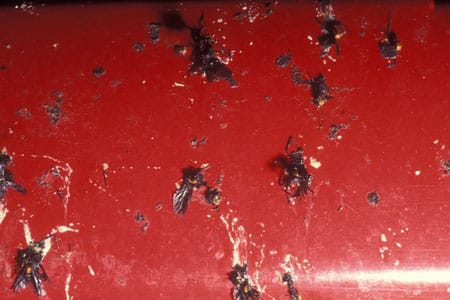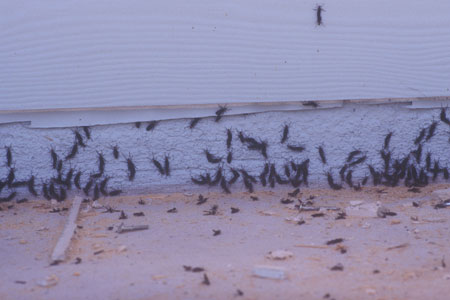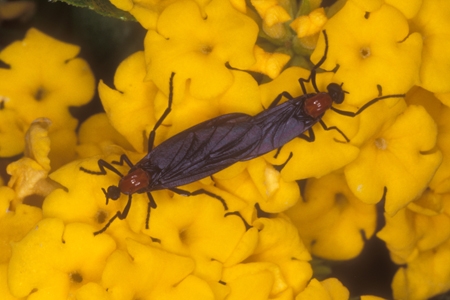Home » Bugs » Other Bugs »
Active Seasons


Lovebug Appearance and Size Facts
Known for their ability to be an annoyance for drivers and homeowners across Florida, lovebugs are a problem nobody wants to have to deal with. Although they don’t bite, lovebugs have the ability to reproduce at a fast rate and wreak havoc with their presence. Our team at Hulett Environmental Services has gathered information about these pesky invaders so you can take proactive steps against a future infestation.
To start, here are some common traits and characteristics of lovebugs:
- Body: Long and narrow bodies with legs coming out from the side of the body
- Color: Black with a reddish-orange area on the top of its thorax
- Size: Lovebugs are typically 1/2 inch in length
- Wings: Generally have smoky-colored wings but are particularly poor fliers
Distinguishing Lovebugs From Other Bugs
Even though lovebugs are a part of the family of March flies, what makes lovebugs different from their family members is their slightly acidic body chemistry. The other members of the March fly family have the ability to bite and sting, while lovebugs do not. However, when a swarm is near your Florida home, it can be difficult to identify your infestation without professional help.
We offer lovebug control in the following locations and their surrounding areas:

Behavior and Habitat of Lovebugs
Adult lovebugs primarily feed off plant nectar. Their reproduction cycle is quite interesting, as the male and female are attached by the abdomen until the male dies. From there, the female drags the male’s body until she lays her eggs. This process only takes a few days and, if left unnoticed, can lead to a large infestation at a swift rate.
Usually, there are two traditional seasons of flights from April to May and August to September. With so many lovebugs in a single flight, these seasons can cause chaos for Florida homeowners and drivers alike.

Signs of Infestation of Lovebugs
Keep your eyes out for dead lovebugs, as this is a potential sign of a female in the process of laying her eggs and should be monitored carefully. Another way to surely determine a lovebug problem is through an accumulation of them on your vehicle. Lovebugs are drawn to the smell of exhaust, so you will often find them splattered across the grill, headlights and windshield of your car.

Tips for Prevention of Lovebugs
Lovebugs are attracted to humid and wet climates, yard debris, and home landscapes such as mulch and flower beds. By eliminating stagnant water near your home and regularly mowing your lawn, this may help love bug larvae die off. That being said, lovebug larvae can lead to the increased presence of additional pests such as birds and other predatory insects that can wreak havoc in your Florida home.
Getting Rid of Lovebugs
Since lovebugs are subject to many natural attractants, it’s an uphill battle removing an infestation on your own. Even with the preventive precautions that can be taken, success is not guaranteed when controlling your lovebug problem solo. For the most effective results, calling on professional pest control services, such as the ones offered by Hulett, is your ideal solution.
Effective Lovebug Control Solutions
Get the best lovebug control for your Florida home by calling Hulett Environmental Services. With over 50 years of experience, our team provides preventive treatments for lovebugs and a wide range of other pests. Ready to get the ball rolling? Schedule your free inspection with our team online to get started today!



